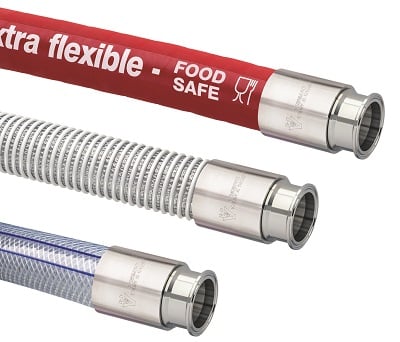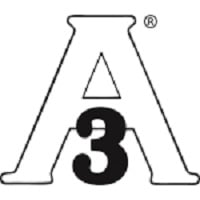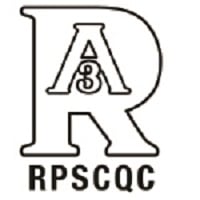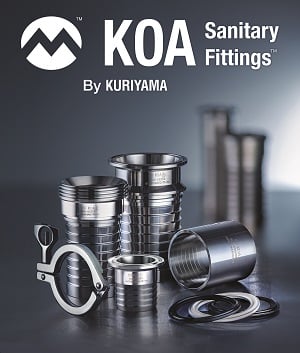When supplying hose assemblies for use in the food and beverage industry, special attention must be given Figure 1: Timothy O’Neill. Source: Kuriyama to ensure they meet the customer’s food safety requirements.
Figure 1: Timothy O’Neill. Source: Kuriyama to ensure they meet the customer’s food safety requirements.
In addition to consumer safety, there’s increased attention to do so as a response to the Food Safety Modernization Act (FSMA), requiring facilities to implement a written food safety plan and hazard analysis.
“Food grade”
The basic requirement for food and beverage hose assemblies is that they’re what is considered “food grade,” meaning they’re compliant with the relevant requirements of the U.S. Food and Drug Administration’s (FDA’s) Code of Federal Regulations Title 21. Commonly referred to as FDA CFR 21, it defines acceptable criteria for rubber and polymeric materials intended for use as food contact surfaces, such as in the case of industrial hose.
However, the FDA does not approve individual hose or couplings as having met these requirements — with the key word here being “approve.” Compliance with FDA CFR 21 is a self-certification, meaning it is purely Figure 2: The 3-A symbol is a registered mark of 3-A SSI. Source: Kuriyama the responsibility of the manufacturer to verify the materials used are compliant with the requirements of the regulation, with no outside verification required.
Figure 2: The 3-A symbol is a registered mark of 3-A SSI. Source: Kuriyama the responsibility of the manufacturer to verify the materials used are compliant with the requirements of the regulation, with no outside verification required.
However, there are various agencies that do actively certify certain industrial hose and fittings as having met food safety criteria, such as NSF, USDA and the 3-A Sanitary Standards Organization (3-A SSI).
3-A Sanitary Standards
3-A SSI is growing in attention as a requirement by a wide variety of food and beverage producers.
Originally founded to regulate process equipment in the dairy industry, 3-A SSI is a non-profit organization, dedicated to the safety of consumers of food, beverage and pharmaceutical products. This is done through the development of the 3-A Sanitary Standards and Accepted Practices for sanitary equipment design, fabrication and materials of construction, which help ensure food meant for human consumption is free from contamination by requiring food processing equipment be that of hygienic design. The requirements of the 3-A Sanitary Standards vary depending on the equipment type and specific process and include criteria such as materials of construction, surface finish, non-toxicity, porosity, corrosion resistance and cleanability.
3-A is accredited by the American National Standards Institute (ANSI) and audited in accordance with ANSI Essential Requirements. The 3-A Administrative Council includes representatives of the USDA and FDA.
The 3-A symbol
 Figure 3: The 3-A logo. Source: Kuriyama
Figure 3: The 3-A logo. Source: Kuriyama
The 3-A symbol is a registered mark of 3-A SSI, used to convey conformity of equipment designed and manufactured to a particular 3-A Sanitary Standard. Whenever shown in conjunction with equipment, it provides assurances that the product is manufactured in conformance with the relevant 3-A standard.
Benefits of hygienically designed hose assemblies
• Improved food safety
• Improved food quality and taste
• Longer food shelf life
• Easier and more reliable equipment cleanability
• Demonstratable sanitary regulation conformance
 Figure 4: RPSCQC mark. Source: KuriyamaSimilar to the FDA, the 3-A SSI organization does not certify individual hoses, but rather supplies standards for certification of the plastic materials (3-A 20-27) and rubber materials (3-A 18-03) used in their manufacture. Industrial hoses meeting these requirements may state that they are manufactured from 3-A certified materials.
Figure 4: RPSCQC mark. Source: KuriyamaSimilar to the FDA, the 3-A SSI organization does not certify individual hoses, but rather supplies standards for certification of the plastic materials (3-A 20-27) and rubber materials (3-A 18-03) used in their manufacture. Industrial hoses meeting these requirements may state that they are manufactured from 3-A certified materials.
3-A provides for the certification of sanitary fittings through the introduction of their RPSCQC mark. The RPSCQC mark was developed for products used as replacement parts or system components, and affirms the products adhere to 3-A design criteria. As a Figure 5: The Sanitary Hose and Coupling Guide. Source: Kuriyama component of the overall hose assembly, sanitary hose fittings fall under this category. Sanitary fittings certified to this standard may bear the 3-A RPSCQC mark, verifying to the user the fitting meets the relevant 3-A design criteria. Kuriyama’s line of KOA Sanitary Fittings are certified to this standard. Also, Kuriyama’s lines of Tigerflex, Kuri Tec and Alfagomma include a wide variety of hoses meeting their relevant 3-A material standards. A downloadable, quick reference guide to these products can be viewed here: Sanitary Hose and Coupling Guide.
Figure 5: The Sanitary Hose and Coupling Guide. Source: Kuriyama component of the overall hose assembly, sanitary hose fittings fall under this category. Sanitary fittings certified to this standard may bear the 3-A RPSCQC mark, verifying to the user the fitting meets the relevant 3-A design criteria. Kuriyama’s line of KOA Sanitary Fittings are certified to this standard. Also, Kuriyama’s lines of Tigerflex, Kuri Tec and Alfagomma include a wide variety of hoses meeting their relevant 3-A material standards. A downloadable, quick reference guide to these products can be viewed here: Sanitary Hose and Coupling Guide.
Additionally, 3-A provides for the certification of industrial hose assemblies under their 62-02 hose assembly standard. To be considered for certification to the 62-02 standard, the individual assembly components must adhere to their respective 3-A sanitary design standards, the assembly must be clearly marked or labeled with the name and address of the symbol holder and any bulge created during the crimping process may not rise above the fitting ID beyond a maximum allowable height. Also, the assembler must demonstrate a written fabrication and QC program. The NAHAD Hose Safety Institute (HSI) provides a variety of helpful resources to their members beneficial in the development of such guidelines, such as the Guide for the Fabrication of Industrial Hose Assemblies.
For more information on sanitary hose assemblies, contact a Kuriyama sales representative or email sales@kuriyama.com.
